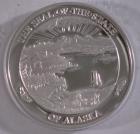2002 Alaska Medallion - The King Crab


Total one ounce proof mintage: 5,677
Total one ounce proof mintage: 146
Current List Price $225.00
Our Price $175.00
Gary Kuchinka of Eagle River, Alaska designed this medallion. In keeping with the theme of Alaskan animals he decided to draw an Alaskan king crab, but soon realized there were few existing photographs to serve as reference. Fortunately, he was able to buy a complete, pre-cooked, frozen, five-pound Alaskan king crab at a local seafood market for $89. The crab was thawed out, positioned in numerous ways, photographed and promptly eaten. In Alaska there are three commercial king crab species...
Red king crabs have been the commercial "king" of Alaska's crabs. It occurs from British Columbia to Japan with Bristol Bay and the Kodiak Archipelago being the centers of its abundance in Alaska. Blue king crabs live from Southeastern Alaska to Japan with the Pribilof and St. Matthew islands being their highest abundance areas in Alaska. Golden king crabs are distributed from British Columbia to Japan with the Aleutian Islands their Alaska stronghold of abundance.
King crabs have "tails," or abdomens, that are distinctive, being fan shaped and tucked underneath the rear of the shell. They also have five pairs of legs: the first bears their claws or pincers, the right claw is usually the largest on the adults, the next three pairs are their walking legs, and the fifth pair of legs are small and normally tucked underneath the rear portion of their carapace (the shell covering their back). Adult females, to clean their embryos use these specialized legs, and the male uses them to transfer sperm to the female during mating.
Adult females brood thousands of embryos underneath their tail flap for about a year's time. When the embryos are fully developed they hatch as swimming larvae, but they are still susceptible to the movements of tide currents. After feeding on plant and animal plankton for several months and undergoing several body changes with each molt, the larvae settle to the ocean bottom and molt into non-swimmers, looking for the first time like king crabs as we normally think of them, except they are smaller than a dime. Red king crabs settle in waters less than 90 feet deep.
Silver Trivia
Silver plays a role in the collection of solar energy which requires an efficient reflection of solar heat. Silver is the best reflector of thermal energy (after gold). Near Barstow, California, 1,926 silver-coated mirrors reflect solar heat onto black-coated stainless steel tubes atop a 300-foot tower. This heats the tubes and the nitrate salt inside them to over 1050oF. The scalding hot salt is then piped to boilers turning water to steam which drives steam turbines geared to electric generators. They now generate sufficient electricity to power 10,000 homes.
